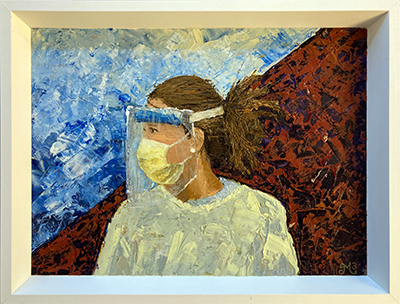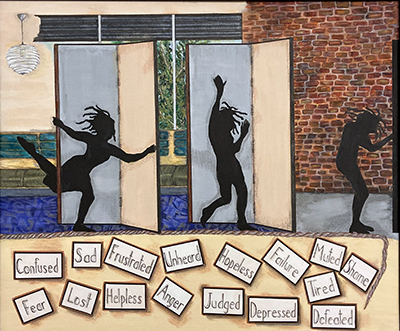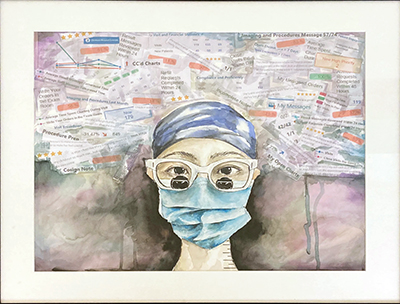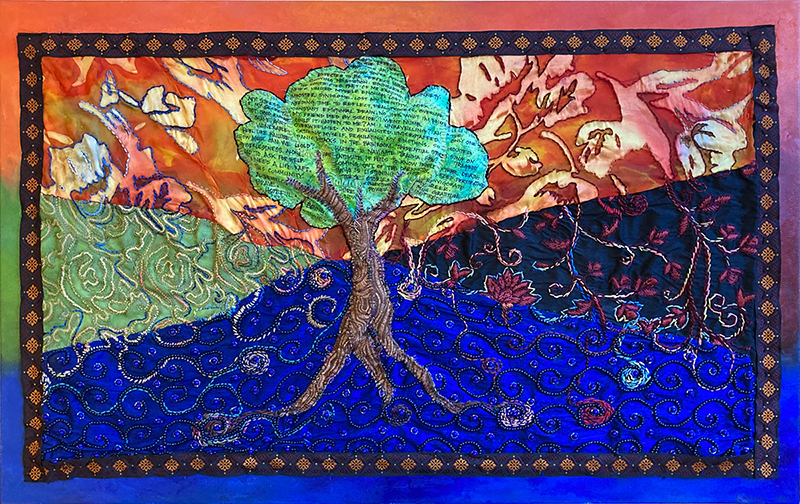TRAVELING EXHIBIT: ‘WE ARE ALL ARTISTS’
Campus caregivers build resilience through creative expression
By Greg Glasgow
April 2024
The hopes, dreams, fears, and anxieties of health care workers across Colorado, including the University of Colorado Anschutz Medical Campus, were on display last fall in an art exhibit in the lobby of Children’s Hospital Colorado. “We Are All Artists: Creations By Healthcare Workers” featured artwork created by participants in the Colorado Resiliency Arts Lab (CORAL), a 12-week creative arts therapy program aimed at lowering rates of stress, anxiety, and burnout.
Filling a hallway just off the main lobby of Children’s Colorado with swirls of bright color, stunning text panels, and striking images of people and places on the CU Anschutz Campus and beyond, the exhibition spotlighted all the art forms created by CORAL participants, including visual art, music, writing, and dance.
“There have been several articles published in various journals about the impact of CORAL,” says Jasmine Chu, arts coordinator for Children’s Colorado.

Not a Drill by Maddison Fritz, RN
“We wanted to break that impact out of scientific journals and into a forum that’s more accessible to more people.”
THERAPY AND CATHARSIS

Breaking Through by Audrey Jackson
Funded by the National Endowment for the Arts, the CORAL program is a partnership among the University of Colorado School of Medicine, the Ponzio Creative Arts Therapy Program at Children’s Colorado, and the Denver-based Lighthouse Writers Workshop. The initiative has welcomed seven cohorts since its inception in fall 2020, and organizers of the “We Are All Artists” exhibit reached out to participants in all seven to solicit submissions.
Every artist who wanted to participate is included in the show, which was on display from November 16 through January 19 at Children’s Colorado. The exhibit then traveled to Lighthouse Writers Workshop headquarters before going on display at the Colorado state capital.
“Art gives people a medium to express themselves about traumas or difficulties that are hard to talk about,” says CORAL director Marc Moss, MD, a professor of medicine in the Division of Pulmonary Sciences and Critical Care Medicine.
“By putting it down, either writing, painting, making a song, or dancing, CORAL allows you a way to get those feelings out there. CORAL allows you to talk about issues with people who understand what you’re dealing with. It builds a sense of community and gives people skills to better cope with the stresses in their job.”
INTROSPECTION AND EXPRESSION
The artwork bears that out — in the text accompanying her piece “Data,” a self-portrait of the artist surrounded by snippets of medical instructions, orders, and reviews, Jennifer Jung, MD, associate professor of ophthalmology, writes that “My time at CORAL was an opportunity to pause from the busyness of work to acknowledge my emotions and find strength through introspection and expression. My art is a reflection of what has been lying beneath the surface — what I hesitated to unveil and confront. Through CORAL, I was reminded that there is strength and beauty in vulnerability.”
Other pieces employ media beyond the traditional canvas — “Not a Drill,” by nurse Maddison Fritz, RN, is a harrowing account of being on the frontlines of the COVID-19 pandemic, written on the front of a transparent plastic medical shield; other pieces incorporate scrubs and surgical gloves. The exhibit also includes video of movement-based pieces, portfolios of work created by writing program participants, and QR code links to songs created by CORAL participants and facilitators.

Data by Jennifer Jung, MD
“Most of the artists here have never exhibited in a gallery before,” Chu says. “This is the first time they’ve done this, and it’s been powerful to see them witnessing their own art in the gallery or seeing their teams come over to see their art down here. It’s in a high-traffic area, and it’s been cool to see the response people have to the show.”
Some of the pieces depict medical settings, while others capture the joys and struggles of life outside the hospital walls.
“As a pulmonary critical care doctor, I thought most of the work should be focused on the stresses and traumas that occur in the workplace,” Moss says. “People bring things with them to work — stresses they have outside of work or societal issues. Some of the artwork deals with stresses from work, but some of it come from the feeling that issues that they bring with them to work are not being addressed effectively.”
EFFECTIVENESS AND GRATITUDE
“We Are All Artists” is a testament to the resiliency and expressiveness of its featured artists, but it’s also a testament to the effectiveness of CORAL, which was shown by Moss and others to measurably lower rates of stress and anxiety.
“It’s really helping people. The data shows it,” Moss says. “We also have anecdotal data where people have written to us to say things like, ‘Thank you so much. I wish I’d done this years ago. I’m so much happier in my life and my job, and my family notices it. It’s really remarkable.”
The Colorado Resiliency Arts Lab is among the 2024 recipients of the Colorado Business Committee for the Arts’ Business for the Arts Awards, a statewide event honoring companies and individuals for their partnerships and engagement with the arts.

Coral Tree by Katherine Reed